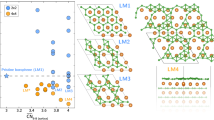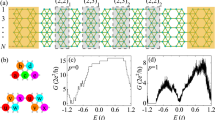Abstract
Two-dimensional (2D) boron (that is, borophene) was recently synthesized following theoretical predictions1,2,3,4,5. Its metallic nature and high in-plane anisotropy combine many of the desirable attributes of graphene6 and monolayer black phosphorus7. As a synthetic 2D material, its structural properties cannot be deduced from bulk boron, which implies that the intrinsic defects of borophene remain unexplored. Here we investigate borophene line defects at the atomic scale with ultrahigh vacuum (UHV) scanning tunnelling microscopy/spectroscopy (STM/STS) and density functional theory (DFT). Under suitable growth conditions, borophene phases that correspond to the v1/6 and v1/5 models are found to intermix and accommodate line defects in each other with structures that match the constituent units of the other phase. These line defects energetically favour spatially periodic self-assembly that gives rise to new borophene phases, which ultimately blurs the distinction between borophene crystals and defects. This phenomenon is unique to borophene as a result of its high in-plane anisotropy and energetically and structurally similar polymorphs. Low-temperature measurements further reveal subtle electronic features that are consistent with a charge density wave (CDW), which are modulated by line defects. This atomic-level understanding is likely to inform ongoing efforts to devise and realize applications based on borophene.
This is a preview of subscription content, access via your institution
Access options
Access Nature and 54 other Nature Portfolio journals
Get Nature+, our best-value online-access subscription
$29.99 / 30 days
cancel any time
Subscribe to this journal
Receive 12 print issues and online access
$259.00 per year
only $21.58 per issue
Buy this article
- Purchase on Springer Link
- Instant access to full article PDF
Prices may be subject to local taxes which are calculated during checkout





Similar content being viewed by others
References
Mannix, A. J. et al. Synthesis of borophenes: anisotropic, two-dimensional boron polymorphs. Science 350, 1513–1516 (2015).
Feng, B. et al. Experimental realization of two-dimensional boron sheets. Nat. Chem. 8, 563–568 (2016).
Zhang, Z., Yang, Y., Gao, G. & Yakobson, B. I. Two-dimensional boron monolayers mediated by metal substrates. Angew. Chem. Int. Ed. 54, 13022–13026 (2015).
Wu, X. et al. Two-dimensional boron monolayer sheets. ACS Nano 6, 7443–7453 (2012).
Tang, H. & Ismail-Beigi, S. Self-doping in boron sheets from first principles: a route to structural design of metal boride nanostructures. Phys. Rev. B 80, 170 (2009).
Novoselov, K. S. et al. Electric field effect in atomically thin carbon films. Science 306, 666–669 (2004).
Liu, X., Ryder, C. R., Wells, S. A. & Hersam, M. C. Resolving the in-plane anisotropic properties of black phosphorus. Small Methods 1, 1700143 (2017).
Mannix, A. J., Kiraly, B., Hersam, M. C. & Guisinger, N. P. Synthesis and chemistry of elemental 2D materials. Nat. Rev. Chem. 1, 0014 (2017).
Zhang, Z. et al. Substrate-induced nanoscale undulations of borophene on silver. Nano Lett. 16, 6622–6627 (2016).
Tsafack, T. & Yakobson, B. I. Thermomechanical analysis of two-dimensional boron monolayers. Phys. Rev. B 93, 165434 (2016).
Wang, H. et al. Strain effects on borophene: ideal strength, negative Poisson’s ratio and phonon instability. New J. Phys. 18, 073016 (2016).
Zhang, Z., Yang, Y., Penev, E. S. & Yakobson, B. I. Elasticity, flexibility, and ideal strength of borophenes. Adv. Funct. Mater. 27, 1605059 (2017).
Liu, X. et al. Self-assembly of electronically abrupt borophene/organic lateral heterostructures. Sci. Adv. 3, e1602356 (2017).
Feng, B. et al. Dirac fermions in borophene. Phys. Rev. Lett. 118, 096401 (2017).
Penev, E. S., Kutana, A. & Yakobson, B. I. Can two-dimensional boron superconduct? Nano Lett. 16, 2522–2526 (2016).
Huang, P. Y. et al. Grains and grain boundaries in single-layer graphene atomic patchwork quilts. Nature 469, 389–392 (2011).
Zhao, L. et al. Visualizing individual nitrogen dopants in monolayer graphene. Science 333, 999–1003 (2011).
van der Zande, A. M. Grains and grain boundaries in highly crystalline monolayer molybdenum disulphide. Nat. Mater. 12, 554–561 (2013).
Liu, X., Balla, I., Bergeron, H. & Hersam, M. C. Point defects and grain boundaries in rotationally commensurate MoS2 on epitaxial graphene. J. Phys. Chem. C 120, 20798–20805 (2016).
Hong, J. et al. Exploring atomic defects in molybdenum disulphide monolayers. Nat. Commun. 6, 6293 (2015).
Muzychenko, D. A., Schouteden, K., Panov, V. I. & Van Haesendonck, C. Formation of Co/Ge intermixing layers after Co deposition on Ge(111)2 × 1 surfaces. Nanotechnology 23, 435605 (2012).
Leibsle, F. M., Dhesi, S. S., Barrett, S. D. & Robinson, A. W. STM observations of Cu(100)−c(2×2)N surfaces: evidence for attractive interactions and an incommensurate c(2×2)structure. Surf. Sci. 317, 309–320 (1994).
Xu, T. T. et al. Crystalline boron nanoribbons: synthesis and characterization. Nano Lett. 4, 963–968 (2004).
Moras, P., Mentes, T. O., Sheverdyaeva, P. M., Locatelli, A. & Carbone, C. Coexistence of multiple silicene phases in silicon grown on Ag(111). J. Phys. Condens. Matter 26, 185001 (2014).
Feng, B. et al. Evidence of silicene in honeycomb structures of silicon on Ag(111). Nano Lett. 12, 3507–3511 (2012).
Zhuang, J. et al. Investigation of electron–phonon coupling in epitaxial silicene by in situ Raman spectroscopy. Phys. Rev. B 91, 161409 (2015).
Guan, J., Zhu, Z. & Tománek, D. High stability of faceted nanotubes and fullerenes of multiphase layered phosphorus: a computational study. Phys. Rev. Lett. 113, 226801 (2014).
Aierken, Y., Leenaerts, O. & Peeters, F. M. Defect-induced faceted blue phosphorene nanotubes. Phys. Rev. B 92, 104104 (2015).
Xiang, P. et al. Metallic borophene polytypes as lightweight anode materials for non-lithium-ion batteries. Phys. Chem. Chem. Phys. 19, 24945–24954 (2017).
Huang, Y., Shirodkar, S. N. & Yakobson, B. I. Two-dimensional boron polymorphs for visible range plasmonics: a first-principles exploration. J. Am. Chem. Soc. 139, 17181–17185 (2017).
Foley, E. T., Yoder, N. L., Guisinger, N. P. & Hersam, M. C. Cryogenic variable temperature ultrahigh vacuum scanning tunneling microscope for single molecule studies on silicon surfaces. Rev. Sci. Instrum. 75, 5280–5287 (2004).
Brockenbrough, R. T. & Lyding, J. W. Inertial tip translator for a scanning tunneling microscope. Rev. Sci. Instrum. 64, 2225–2228 (1993).
Acknowledgements
X.L. and M.C.H. acknowledge support from the Office of Naval Research (ONR N00014-17-1-2993) and the National Science Foundation Materials Research Science and Engineering Center (NSF DMR-1720139). The computational work at Rice University was supported by the Army Research Office (W911NF-16-1-0255) and by the Robert Welch Foundation (C-1590); Z.Z. acknowledges NSFC-11772153 support at a later stage. Z.Z., L.W. and B.I.Y. also acknowledge support by the US DOE Office of Science (DOE DE-SC0012547) and the Research Fund of State Key Laboratory of Mechanics and Control of Mechanical Structures (no. MCMS-0415K01). X.L. further acknowledges support from a Ryan Fellowship that is administered through the Northwestern University International Institute for Nanotechnology. The authors thank A. J. Mannix, M. Han, I. Balla, S. Li, E. S. Penev and Q. Ruan for valuable discussions.
Author information
Authors and Affiliations
Contributions
X.L. and M.C.H. conceived the experiments. X.L. performed the sample preparation, STM/STS and XPS characterization. Z.Z., L.W. and B.I.Y. designed the models. Z.Z. and L.W. performed the DFT simulations. X.L. provided assistance with the model construction. All the authors contributed to the data interpretation and manuscript writing.
Corresponding author
Ethics declarations
Competing interests
The authors declare no competing interests.
Additional information
Publisher’s note: Springer Nature remains neutral with regard to jurisdictional claims in published maps and institutional affiliations.
Supplementary information
Supplementary Information
Supplementary Figures 1–11, Supplementary Table 1 and Supplementary Note 1
Rights and permissions
About this article
Cite this article
Liu, X., Zhang, Z., Wang, L. et al. Intermixing and periodic self-assembly of borophene line defects. Nature Mater 17, 783–788 (2018). https://doi.org/10.1038/s41563-018-0134-1
Received:
Accepted:
Published:
Issue Date:
DOI: https://doi.org/10.1038/s41563-018-0134-1
This article is cited by
-
Theory of sigma bond resonance in flat boron materials
Nature Communications (2023)
-
Experimental evidence of surface copper boride
Nano Research (2023)
-
Chemically identifying single adatoms with single-bond sensitivity during oxidation reactions of borophene
Nature Communications (2022)
-
Borophene synthesis beyond the single-atomic-layer limit
Nature Materials (2022)
-
Micrometre-scale single-crystalline borophene on a square-lattice Cu(100) surface
Nature Chemistry (2022)



